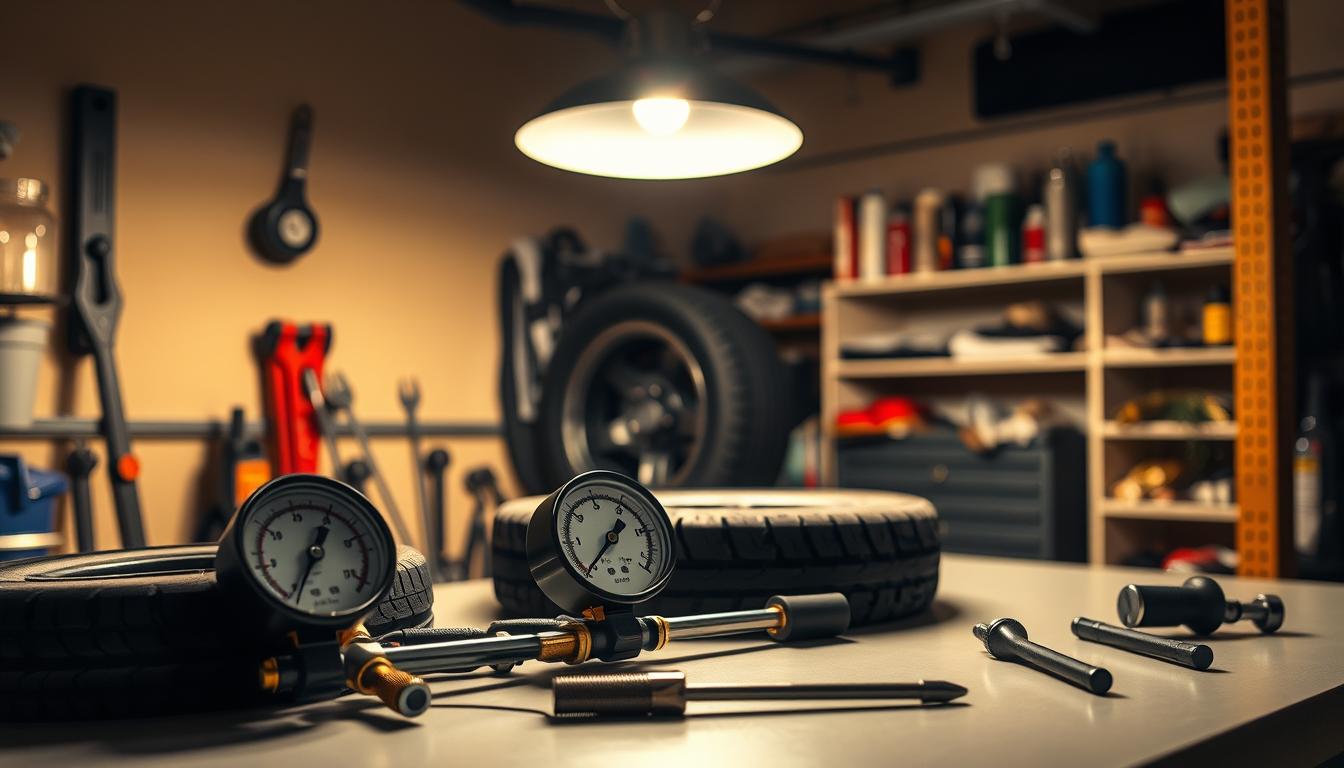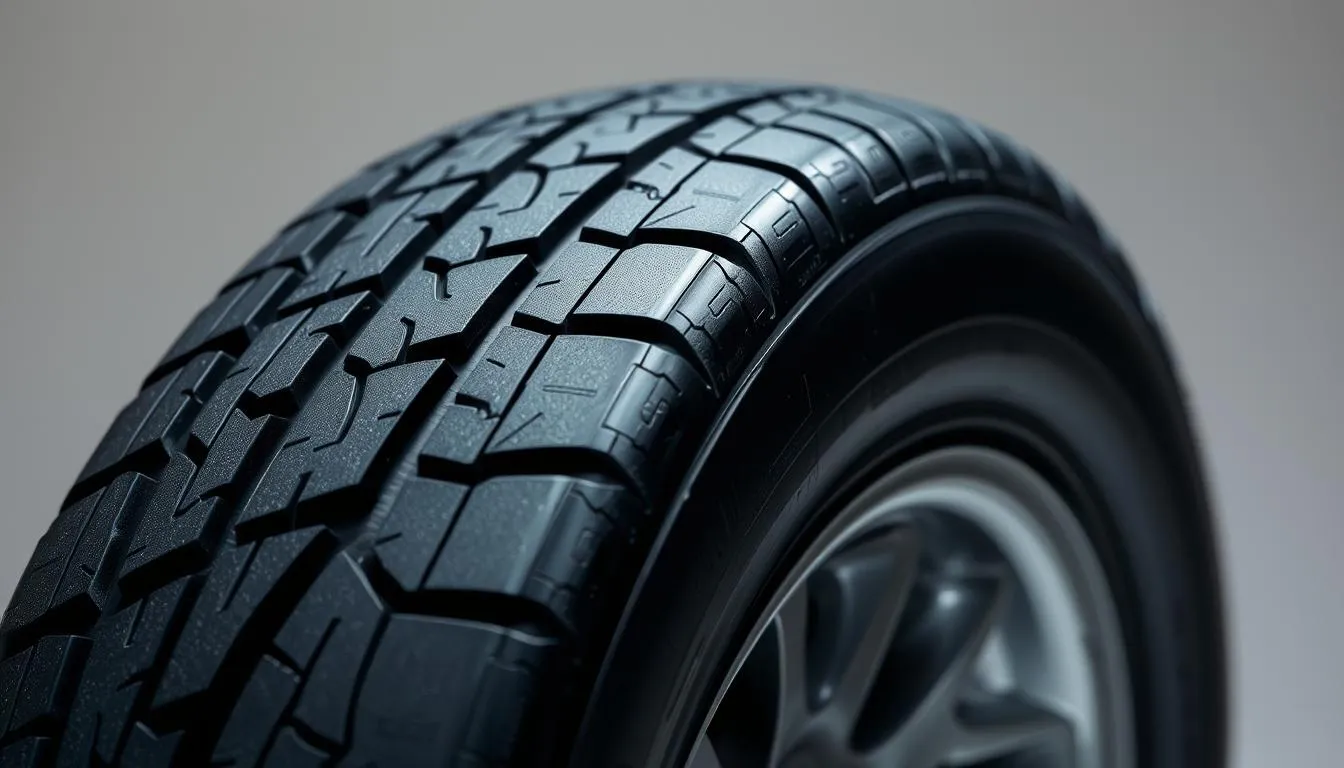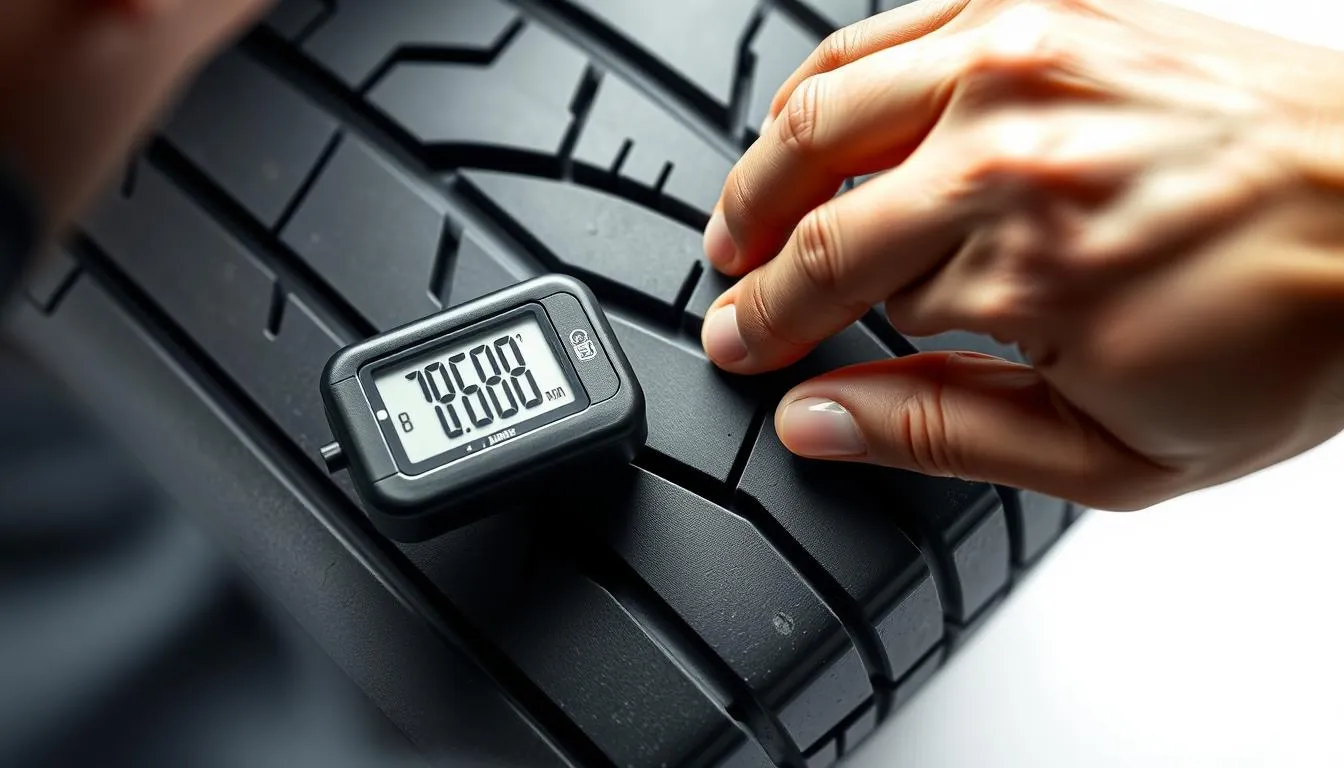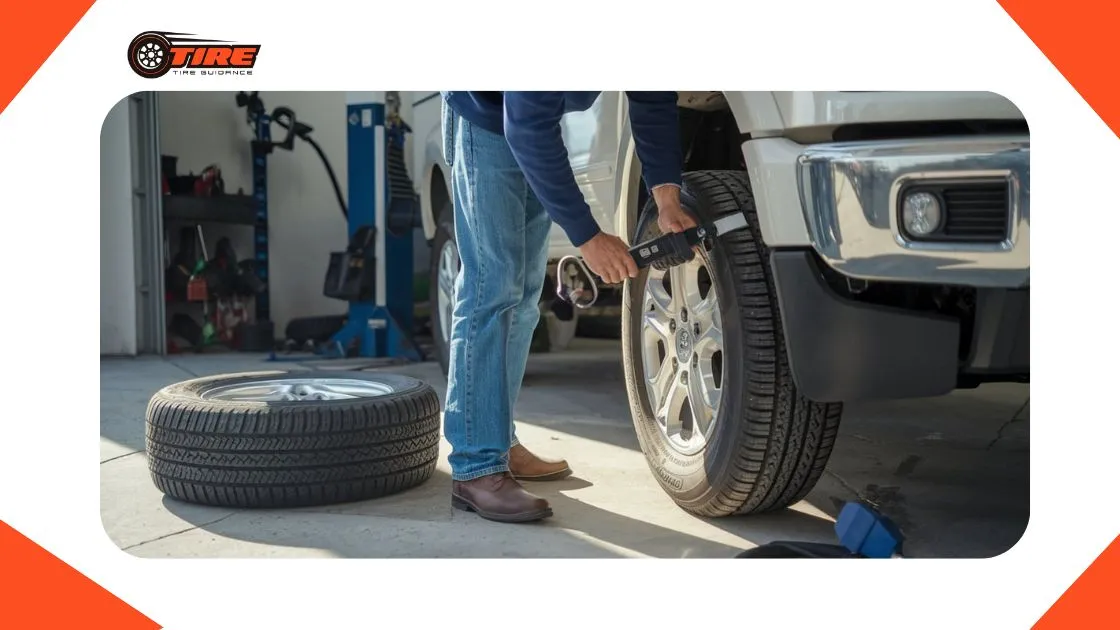As a car owner, I understand how vital tire maintenance is. It ensures a safe and smooth ride. The right care can extend your tires’ life and prevent accidents. It also boosts your car’s fuel efficiency and performance.

My expert advice will help you keep your car in great shape. You’ll enjoy safer and more comfortable drives. I’ll share tips on checking tire pressure and rotating them for even wear.
Table Of Contents
- 1 Key Takeaways
- 2 Why Proper Tire Maintenance Tips Matter for Your Vehicle
- 3 Essential Tools for Tire Care at Home
- 4 Understanding Your Tire Pressure Requirements
- 5 My Professional Tire Rotation Schedule
- 6 Reading Tire Wear Patterns Like a Pro
- 7 Mastering the Art of Tread Depth Measurement
- 8 Seasonal Tire Care and Weather Considerations
- 9 Alignment and Balancing: When It’s Time to Visit a Pro
- 10 Emergency Tire Situations and Quick Fixes
- 11 How My Tire Maintenance Tips Extend Tire Life
- 12 Signs It’s Time to Replace Your Tires
- 13 Conclusion: Implementing Your Tire Care Strategy
- 14 FAQ
Key Takeaways
- Proper tire maintenance tips can improve fuel efficiency and handling
- Regular tire care advice can extend the life of your tires
- Checking tire pressure is essential for safe driving
- Tire rotation is crucial for even tread wear
- Following tire maintenance tips can prevent accidents and improve overall performance
Why Proper Tire Maintenance Tips Matter for Your Vehicle
As a vehicle owner, I’ve learned that proper tire maintenance is key for my safety on the road. By following a tire maintenance checklist, I can avoid accidents and tire problems. Regular care also boosts fuel economy, saving me money.
Knowing how tire maintenance affects safety, fuel, and cost is vital. A well-maintained tire improves traction and handling, lowering accident risks. It also saves fuel, up to 3%, which can lead to big savings over time. To do this, I check tire pressure, rotate tires, and inspect tread depth regularly.
- Checking tire pressure at least once a month
- Rotating tires every 5,000 to 8,000 miles
- Inspecting tread depth regularly
By following these tips and keeping up with tire care, my vehicle runs smoothly, safely, and efficiently. Next, I’ll talk about the essential tools for tire care at home.
Essential Tools for Tire Care at Home
To take care of your tires at home, you need the right tools. A tire pressure gauge is key to check if your tires are at the right pressure. A lug wrench is also crucial for loosening lug nuts when you rotate your tires.
A tire rotation kit is a smart investment. It includes a jack, lug wrench, and wheel chocks. This makes rotating your tires safe and easy. By using the right tools, you can keep your vehicle in great shape.
Other useful tools include a tire depth gauge and a flashlight. These help you check your tires, even in the dark. With these tools, you can keep your tires in top condition. Remember, taking care of your tires is important for safety, fuel efficiency, and tire longevity.

Investing in the right tools and following best practices helps keep your tires in good shape. This improves safety and reduces wear and tear on your vehicle. It also saves you money in the long run.
Understanding Your Tire Pressure Requirements
Proper tire pressure is key for your vehicle’s safety, fuel efficiency, and tire maintenance tips for longevity. To get the best tire performance, knowing your vehicle’s recommended tire pressure is crucial.
Finding Your Vehicle’s Recommended PSI
The owner’s manual or the tire information placard on the driver’s side doorjamb will tell you the recommended tire pressure. This pressure is measured in pounds per square inch (PSI).
When to Check Tire Pressure
Check your tire pressure at least once a month and before long trips. Always check when the tires are cold. Driving can warm up the tires and change the pressure reading.
Temperature Effects on Tire Pressure
Temperature changes tire pressure. Cold temperatures lower it, while hot temperatures raise it. Remember this when checking your tire pressure for an accurate reading.
By following these tire maintenance tips for longevity, you can extend your tires’ life. This ensures your vehicle runs safely and efficiently.
My Professional Tire Rotation Schedule
As a car owner, I know how vital tire maintenance tips for safety are. Regular tire rotation is key for even tread wear and avoiding tire failure. Here, I’ll share my expert tire rotation schedule to help you keep your tires in great shape.
First, it’s important to know when to rotate your tires. The usual advice is to do it every 5,000 to 8,000 miles. But, this can change based on your car’s make, model, and how you drive. Always check your owner’s manual for the best advice.
Here’s a simple tire rotation schedule to follow:
- Check your tire pressure monthly
- Rotate your tires every 5,000 to 8,000 miles
- Inspect your tires for signs of wear and damage
By sticking to this schedule and adding tire maintenance tips for safety to your routine, you’ll make your car safer and better to drive. Always look at your owner’s manual for the right way to rotate and maintain your tires.

Regular tire rotation and care can make your tires last longer, save fuel, and improve your car’s performance. By focusing on tire maintenance tips for safety, you’ll have a smoother, safer drive and lower the chance of tire-related accidents.
Reading Tire Wear Patterns Like a Pro
As a beginner, learning to read tire wear patterns is key. It helps you spot issues early and avoid tire failure. With simple tire maintenance tips for beginners, you can manage your tire care. This ensures your vehicle stays safe to drive.
To start, it’s crucial to know the different wear patterns. These include:
- Center wear indicators: These are signs of wear in the center of the tire, often caused by overinflation.
- Edge wear signs: These are signs of wear on the edges of the tire, often caused by underinflation.
- Irregular wear patterns: These are unusual wear patterns that can be caused by a variety of factors, including misaligned wheels or uneven tire wear.

By recognizing these patterns and following tire maintenance tips for beginners, you can spot issues early. Always check your tire pressure and rotate your tires as the manufacturer suggests.
Mastering the Art of Tread Depth Measurement
Measuring tread depth is key for essential tire maintenance tips. It tells you when to replace your tires. You’ll need a tread depth gauge for this. This tool measures the rubber part of your tire that touches the road.
Use the tread depth gauge by inserting the probe into the tire groove. Press it firmly against the tire. The gauge will show the tread depth in inches or millimeters. It’s smart to measure in different spots around the tire for a true reading.

By following these essential tire maintenance tips, you keep your tires in top shape. Always check your tire tread depth. Worn-out tires can cause less traction and increase accident risk. With practice, you’ll get good at measuring tread depth and keep your vehicle safe and running well.
Some important things to remember when measuring tread depth include:
- Always use a tread depth gauge for accurate readings
- Take measurements in multiple locations around the tire
- Check your tire tread depth regularly, ideally once a month
Mastering tread depth measurement and following these essential tire maintenance tips will keep your vehicle in great shape. This ensures your safety on the road.
Seasonal Tire Care and Weather Considerations
As a vehicle owner, it’s key to think about the changing seasons and how they affect your tires. Different weather needs special tire care to keep you safe on the road.
Following good tire maintenance tips can make your tires last longer and improve your car’s performance. Regular checks include tire pressure, rotation, and tread depth.

Summer Maintenance Specifics
In summer, hot weather can make tire pressure rise, risking a blowout. Regularly check and adjust your tire pressure as the manufacturer suggests.
Winter Tire Care Essentials
In winter, cold and icy roads need special attention. Think about getting winter tires or snow chains for better grip and control.
Spring and Fall Transition Tips
Spring and fall weather can be unpredictable, and roads can change fast. Always check your tire pressure and tread depth to keep your car ready for any season.
By following these seasonal tire care tips, your vehicle will always be safe to drive, no matter the weather. Always put tire care first to make your tires last longer and enhance your driving experience.
Alignment and Balancing: When It’s Time to Visit a Pro
As I share my knowledge on how to maintain tires, I stress the need for proper wheel alignment and balancing. These are key for your vehicle’s safety and performance. Here’s a tire maintenance checklist to spot when you need a pro.
Look out for signs like uneven tire wear, vibration, or pulling to one side. If you see these, it’s time to get your wheels checked. A professional mechanic can adjust them for you. This keeps your vehicle safe and running well.
Keeping your vehicle safe and performing well means regular wheel checks. A detailed tire maintenance checklist helps catch problems early. Don’t ignore signs of misalignment or imbalance; a pro can fix it.
By focusing on wheel alignment and balancing, you get a smoother ride and better fuel efficiency. Check your tire maintenance checklist often. If you spot any issues, book a mechanic visit. Your vehicle will be safer, and you’ll drive with confidence.
Emergency Tire Situations and Quick Fixes
As a driver, I’ve faced many emergency tire situations. Staying calm and knowing what to do is key. It’s important to be ready for unexpected tire problems. Here, I’ll share tips on handling sudden flats, temporary fixes, and when to get help.
Keeping yourself and others safe on the road is crucial. Always check your tire pressure, tread depth, and look for wear signs. This can help avoid blowouts or flats.
- Stay calm and move to a safe location
- Turn on your hazard lights to alert other drivers
- Check your tire for any damage or debris
- Use a spare tire or temporary repair kit if necessary
Remember, tire maintenance best practices are about being proactive. Taking care of your tires can prevent unexpected problems. By following these tips, you can ensure a safe and smooth ride.
How My Tire Maintenance Tips Extend Tire Life
Following my tire maintenance tips can make your tires last longer. This ensures your car is always safe to drive. Regular care is key to avoid tire failure, save fuel, and lower accident risks.
For example, keeping tires properly inflated can boost fuel efficiency by up to 3%. This can save you money over time.
My safety-focused tips include regular tire rotations. This spreads out wear evenly, making your tires last longer. Also, check the tread depth and look for uneven wear signs early.
Some main benefits of my tire maintenance tips are:
- Improved fuel efficiency
- Extended tire life
- Reduced risk of accidents
- Cost savings over time
By focusing on tire care, you get a smoother, safer drive. Plus, your vehicle lasts longer. Remember, regular tire maintenance is vital for your safety. So, follow my tips for safety and longevity.
Signs It’s Time to Replace Your Tires
As a vehicle owner, knowing when to replace your tires is key for your safety. Proper tire maintenance is vital. Essential tire maintenance tips help spot when it’s time for a new set. A penny test is a simple way to check tread wear. If Lincoln’s head is visible, it’s time for new tires.
Cracks or bulges on the tire are also warning signs. These can come from poor tire maintenance or wear. Tire maintenance tips for beginners stress the need for regular checks. Look for uneven wear patterns too, which might mean misalignment.
Here are some key things to look for when inspecting your tires:
- Tread depth: Check if the tread is worn down to 2/32 of an inch or less.
- Cracks: Look for cracks in the sidewalls or tread.
- Bulges: Check for bulges or blisters on the tire surface.
By following these essential tire maintenance tips and being aware of the signs, you keep your vehicle safe. Always prioritize tire maintenance tips for beginners. This way, you’ll enjoy a smooth and safe ride.
Conclusion: Implementing Your Tire Care Strategy
Maintaining your tires is key for your vehicle’s safety and performance. By following my tips, you can make a tire care plan that fits your needs and budget. Remember, regular tire care is crucial for a smooth, safe ride and a longer vehicle life.
I’ve shared steps like checking tire pressure and measuring tread depth. These will help you keep your tires in top shape. Stay alert and fix problems quickly to avoid expensive repairs and ensure your tires work well.
Creating a tire care plan is an ongoing task, but it’s worth it. Use these tips to enjoy a well-maintained vehicle. Your tires are vital for your vehicle’s performance. By caring for them, you’ll see better safety, fuel efficiency, and a longer-lasting vehicle.
FAQ
What are the essential tools I need for tire maintenance at home?
To maintain your tires at home, you’ll need a few key tools. A tire pressure gauge is crucial for checking air pressure. A lug wrench is necessary for changing tires. Lastly, a tire rotation kit helps in rotating your tires evenly.
How do I find my vehicle’s recommended tire pressure?
Looking for your vehicle’s recommended tire pressure is easy. Check the driver’s side door jamb sticker or your owner’s manual. This will tell you the ideal PSI for your tires.
How often should I rotate my tires?
Rotating your tires every 5,000 to 8,000 miles is recommended. This ensures even tread wear and prevents tire failure. Regular rotation is key for your tires’ longevity and safety.
How can I read tire wear patterns to identify potential issues?
Learning to read tire wear patterns is important. It helps you spot issues like center wear, edge wear, and irregular patterns. These signs can point to alignment, inflation, or other problems that need fixing.
How do I measure tread depth accurately?
To accurately measure tread depth, use a tread depth gauge. It tells you when it’s time to replace your tires. This ensures they meet the minimum legal requirement for safe driving.
How do I handle emergency tire situations, such as a sudden flat?
In case of a sudden flat, pull over safely. Change the tire with your spare. Then, have the damaged tire repaired or replaced as soon as you can. Knowing how to handle emergencies keeps you safe on the road.
What are the signs that it’s time to replace my tires?
Signs it’s time to replace your tires include excessive tread wear and cracks or bulges in the sidewall. Poor performance in wet or wintry conditions is another sign. Regularly checking your tires helps you know when it’s time for a new set.





